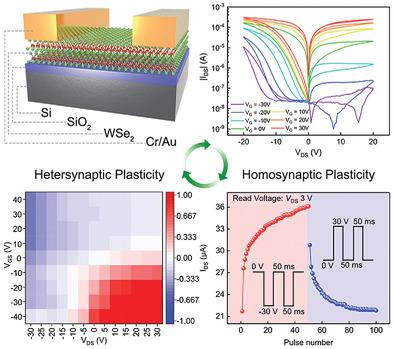Our official English website, www.x-mol.net, welcomes your
feedback! (Note: you will need to create a separate account there.)
Reconfigurable 2D WSe2-Based Memtransistor for Mimicking Homosynaptic and Heterosynaptic Plasticity
Small ( IF 13.0 ) Pub Date : 2021-09-16 , DOI: 10.1002/smll.202103175 Guanglong Ding 1 , Baidong Yang 2, 3 , Ruo-Si Chen 2, 3 , Wen-Ai Mo 2, 3 , Kui Zhou 1 , Yang Liu 3 , Gang Shang 3 , Yongbiao Zhai 3 , Su-Ting Han 3 , Ye Zhou 1
Small ( IF 13.0 ) Pub Date : 2021-09-16 , DOI: 10.1002/smll.202103175 Guanglong Ding 1 , Baidong Yang 2, 3 , Ruo-Si Chen 2, 3 , Wen-Ai Mo 2, 3 , Kui Zhou 1 , Yang Liu 3 , Gang Shang 3 , Yongbiao Zhai 3 , Su-Ting Han 3 , Ye Zhou 1
Affiliation

|
The mimicking of both homosynaptic and heterosynaptic plasticity using a high-performance synaptic device is important for developing human-brain–like neuromorphic computing systems to overcome the ever-increasing challenges caused by the conventional von Neumann architecture. However, the commonly used synaptic devices (e.g., memristors and transistors) require an extra modulate terminal to mimic heterosynaptic plasticity, and their capability of synaptic plasticity simulation is limited by the low weight adjustability. In this study, a WSe2-based memtransistor for mimicking both homosynaptic and heterosynaptic plasticity is fabricated. By applying spikes on either the drain or gate terminal, the memtransistor can mimic common homosynaptic plasticity, including spiking rate dependent plasticity, paired pulse facilitation/depression, synaptic potentiation/depression, and filtering. Benefitting from the multi-terminal input and high adjustability, the resistance state number and linearity of the memtransistor can be improved by optimizing the conditions of the two inputs. Moreover, the device can successfully mimic heterosynaptic plasticity without introducing an extra terminal and can simultaneously offer versatile reconfigurability of excitatory and inhibitory plasticity. These highly adjustable and reconfigurable characteristics offer memtransistors more freedom of choice for tuning synaptic weight, optimizing circuit design, and building artificial neuromorphic computing systems.
中文翻译:

用于模拟同突触和异突触可塑性的可重构 2D 基于 WSe2 的 Memtransistor
使用高性能突触设备模拟同突触和异突触可塑性对于开发类人脑神经形态计算系统以克服传统冯诺依曼架构带来的日益增加的挑战非常重要。然而,常用的突触器件(如忆阻器和晶体管)需要额外的调制终端来模拟异质突触可塑性,并且它们的突触可塑性模拟能力受到低权重可调性的限制。在本研究中,WSe 2制造了用于模拟同突触和异突触可塑性的基于记忆晶体管。通过在漏极或栅极端子上施加尖峰,记忆晶体管可以模拟常见的同突触可塑性,包括尖峰速率依赖性可塑性、成对脉冲促进/抑制、突触增强/抑制和过滤。受益于多端输入和高可调性,可以通过优化两个输入的条件来提高忆阻器的电阻状态数和线性度。此外,该装置可以在不引入额外终端的情况下成功模拟异突触可塑性,并且可以同时提供兴奋性和抑制性可塑性的多功能可重构性。
更新日期:2021-10-14
中文翻译:

用于模拟同突触和异突触可塑性的可重构 2D 基于 WSe2 的 Memtransistor
使用高性能突触设备模拟同突触和异突触可塑性对于开发类人脑神经形态计算系统以克服传统冯诺依曼架构带来的日益增加的挑战非常重要。然而,常用的突触器件(如忆阻器和晶体管)需要额外的调制终端来模拟异质突触可塑性,并且它们的突触可塑性模拟能力受到低权重可调性的限制。在本研究中,WSe 2制造了用于模拟同突触和异突触可塑性的基于记忆晶体管。通过在漏极或栅极端子上施加尖峰,记忆晶体管可以模拟常见的同突触可塑性,包括尖峰速率依赖性可塑性、成对脉冲促进/抑制、突触增强/抑制和过滤。受益于多端输入和高可调性,可以通过优化两个输入的条件来提高忆阻器的电阻状态数和线性度。此外,该装置可以在不引入额外终端的情况下成功模拟异突触可塑性,并且可以同时提供兴奋性和抑制性可塑性的多功能可重构性。











































 京公网安备 11010802027423号
京公网安备 11010802027423号